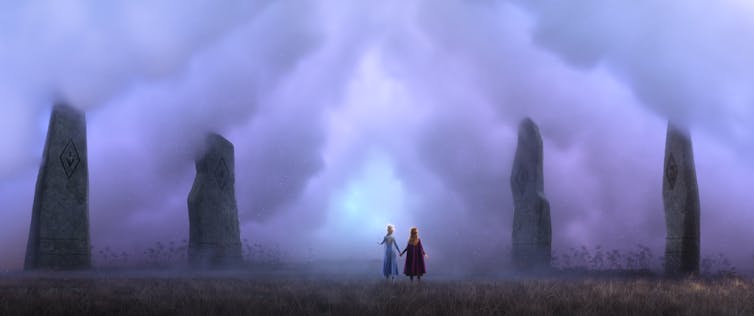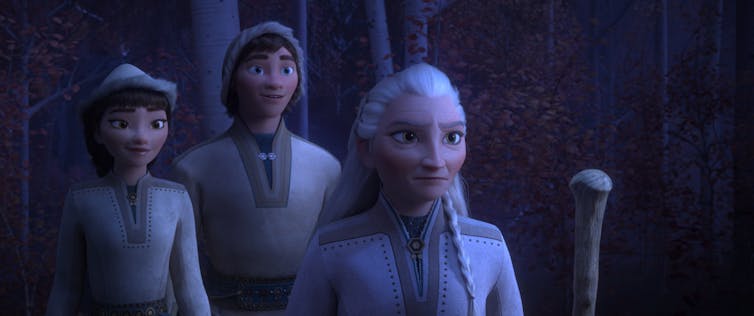Parents across the globe have been dragged into the cinema to watch Disney’s latest icy offering. I, being of them, was expecting Disney’s usual fare – princesses with special powers who, in an amazing feminist twist (because recently Disney do enjoy subverting the princess fairytale genre now they’re “woke”), don’t marry the prince at the end of the film.
In a curve ball, however, Frozen 2 appears to tackle the historically silenced issue of indigenous land rights and repatriations head on. It suggests that, at all costs, land must now be returned to the people it was once stolen from. However, whether it is a genuinely a rewriting of biased colonial historical narratives from the perspective of the dispossessed is up for debate.
Let me provide a bit of context. The film starts with a grand tale which hides a terrible lie, as do all colonial narratives. King Agnarr of Arendelle tells his young daughters, Elsa and Anna, a bedtime tale about their “heroic” grandfather, King Runeard, who sought to establish a treaty with the neighbouring “tribe” of Northuldra. He does this by building a dam on their territory, the Enchanted Forest. To mark the treaty the people of Arendelle invite the Northuldra to celebrate in the Northuldra territories – but the good people of Arendelle are attacked by the “savage” tribespeople.

“We let down our guard, we were charmed, it felt so magical,” King Agnarr tells his daughters, “but they were attacking us”. King Runeard dies but Agnarr (who was then a young prince) escapes with the help of a mysterious saviour. The battle makes the spirits angry (“Air, Water, Fire and Earth”) and in their fury they create a great impenetrable wall of smoke around the Enchanted forest and its people. In a final warning, King Agnarr tells his wide-eyed girls: “We are safe but the forest may wake and we must be prepared.”
Narratives of colonial control
Postcolonial theory examines how literary and historical narratives seek to uphold and legitimise colonial control and the stealing of land from indigenous people. This bedtime story reasserts this, and Frozen 2 is dedicated to unravelling such a damaging colonial myth. The film hinges on the idea that “water has memory,” like the poet Derek Walcott’s poem The Sea Is History, it suggests that water remembers ancestral wrongdoings.
The Northuldra are of course a romanticised portrayal of indigenous people and there is much of the stereotype of the “noble savage” reflected here. They live in a magical forest, are deeply in tune with their natural environment and are innocent and pure. As the lies on which the Kingdom of Arendelle is founded start to unravel, we discover that Anna and Elsa’s mother, Iduna, is from the Northuldra tribe – she was the mysterious saviour who rescued their father during battle.

After Elsa is drawn to the Enchanted forest by a haunting song, she realises she must travel to a glacier named Ahtohalla to find answers. There the past is revealed to her through a series of ice statues – ancestral crimes are literally frozen in time.
It transpires that King Runeard cheated the Northuldra, the dam he built was to weaken their lands and he attacked them while they were defenceless. His reasons for doing so was that they have their own magic and people with magic cannot be trusted. “It makes them think they can stop the will of a king”, he states – echoing colonial fears of indigenous belief systems.
As the deeds of her ancestors are revealed to her, Elsa also becomes an ice statue. Anna realises that the wrongs of the past must be corrected if Elsa and Arendelle are to be saved. “Arendelle has no future unless we make things right”, she proclaims passionately.
Retroactive rehabilitation
For all its worthiness, this is clearly a plotline created in retrospect. It seems in the wake of the negative backlash on social media against the first Frozen – which depicts indigenous songs, musical scores and clothing without any acknowledgement that they are inspired by indigenous culture – Frozen 2 has placed indigenous issues at centre stage. The Northuldra are fictionalised portrayals of the Sámi who are traditionally reindeer herders and whose lands covered parts of present-day Sweden, Finland, Norway and Russia.
The filmmakers worked alongside Sámi experts, formed an advisory group and a contract was signed, the first of its kind, between the Walt Disney Company, the transnational Sámi Council and the Sámi parliament to ensure a culturally sensitive depiction of the inspiration behind the fictional Northuldra people.
From the 1800s onwards, the Sámi have been oppressed and discriminated against. They have been subjected to forced sterilisation programs, segregation, scientific study and ethnic discrimination and prevented from speaking their indigenous languages. Settlers have been encouraged to move on to Sámi lands, money has been invested to eradicate Sámi culture and parliamentary acts have ensured the allocation of their lands to settlers. It seems that the dam in the film may be based on the controversy over the construction of a hydro-electric power station and dam on Sámi land in 1979 in Alta, which brought Sámi rights into the public eye and started a international movement for the protection of the Sámi and their culture.

Anna realises that she must break the dam, which will flood Arendelle, to put things right. She is willing to sacrifice Arendelle and its ill-gotten gains to heal the Northuldra community and return what belongs rightfully to them. By doing this she can save Elsa, free the Northuldra and appease the angry elemental spirits. As she plans to break the dam, she sings a song entitled: “The Next Right Thing”. Reparations are the next right thing to do and she is the woman to do it.
Yet, as expected, the sacrifice is minimal. Elsa arrives just in time to freeze the floodwater before it reaches Arendelle. Order is quickly restored, the spirits are at peace and the wall of smoke around the forest dissolves. The Northuldra and the forest are free. It all ends neatly with marriage, a “new” monarch and the idea of freedom.
So did Disney do the next right thing? Quite frankly, it’s all a bit of a charade. But at least they tried.

